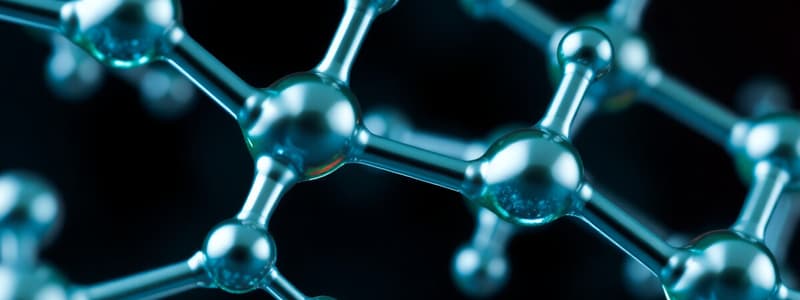Podcast
Questions and Answers
Which metal carbonyl requires the harshest conditions for preparation?
Which metal carbonyl requires the harshest conditions for preparation?
- Mo(CO)6
- Ni(CO)4
- Fe(CO)5 (correct)
- Ru3(CO)12
What characteristic is common among most metal carbonyls?
What characteristic is common among most metal carbonyls?
- They are classified as organometallic compounds. (correct)
- They exhibit more inorganic characteristics than organic.
- They have very strong intermolecular forces.
- They are generally solid at room temperature.
What is the boiling point of nickel tetracarbonyl (Ni(CO)4)?
What is the boiling point of nickel tetracarbonyl (Ni(CO)4)?
- 42°C (correct)
- 150°C
- 80°C
- 103°C
Which statement about mononuclear carbonyls is true?
Which statement about mononuclear carbonyls is true?
What is the coordination number of a metal in a typical metal carbonyl complex?
What is the coordination number of a metal in a typical metal carbonyl complex?
Which carbonyl complex is known to violate the 18-electron rule?
Which carbonyl complex is known to violate the 18-electron rule?
What is the coordination number of V(CO)6 if dimerization were to occur?
What is the coordination number of V(CO)6 if dimerization were to occur?
Which metal in the provided content has 9 valence electrons?
Which metal in the provided content has 9 valence electrons?
How do Mn(CO)5 and Co(CO)4 achieve an 18-electron configuration?
How do Mn(CO)5 and Co(CO)4 achieve an 18-electron configuration?
What temperature does V(CO)6 decompose at?
What temperature does V(CO)6 decompose at?
What did Ludwig Mond contribute to the field of chemistry?
What did Ludwig Mond contribute to the field of chemistry?
Which of the following carbonyl compounds contains a zero oxidation state for the metal?
Which of the following carbonyl compounds contains a zero oxidation state for the metal?
What overall electron configuration do carbonyl complexes aim to achieve?
What overall electron configuration do carbonyl complexes aim to achieve?
What type of complex is formed when carbon monoxide acts as a Lewis acid by accepting electrons?
What type of complex is formed when carbon monoxide acts as a Lewis acid by accepting electrons?
What occurs as a result of backbonding in metal carbonyl complexes?
What occurs as a result of backbonding in metal carbonyl complexes?
How many valence electrons do many low oxidation state organotransition metal complexes aim for?
How many valence electrons do many low oxidation state organotransition metal complexes aim for?
Which of the following statements about CO stretching frequencies is correct?
Which of the following statements about CO stretching frequencies is correct?
What defines an 18-electron configuration in organotransition metal complexes?
What defines an 18-electron configuration in organotransition metal complexes?
In the bonding picture of p-acceptor complexes, what type of orbital is considered antibonding?
In the bonding picture of p-acceptor complexes, what type of orbital is considered antibonding?
What is the result of strong overlap between metal and carbon monoxide in complexes?
What is the result of strong overlap between metal and carbon monoxide in complexes?
What is the oxidation state of the transition metal when determining electron counts for carbon monoxide complexes?
What is the oxidation state of the transition metal when determining electron counts for carbon monoxide complexes?
Which of the following is an example of the transition metals in the carbonyl complexes discussed?
Which of the following is an example of the transition metals in the carbonyl complexes discussed?
Which orbital type does a filled metal d orbital contribute back to in a p-acceptor complex?
Which orbital type does a filled metal d orbital contribute back to in a p-acceptor complex?
What is the primary reason for ligand dissociation in a dissociative mechanism?
What is the primary reason for ligand dissociation in a dissociative mechanism?
Which types of ligands contribute to the trans effect according to their influence?
Which types of ligands contribute to the trans effect according to their influence?
Which statement correctly describes the nature of the trans effect?
Which statement correctly describes the nature of the trans effect?
What is the role of a strong π-acceptor in the associative mechanism?
What is the role of a strong π-acceptor in the associative mechanism?
Which ligand mentioned in the content is characterized as a poor Lewis base?
Which ligand mentioned in the content is characterized as a poor Lewis base?
What is the key interaction involved in backbonding for transition metal carbonyl complexes?
What is the key interaction involved in backbonding for transition metal carbonyl complexes?
In the context of p-acceptor complexes, which statement is true regarding ligands?
In the context of p-acceptor complexes, which statement is true regarding ligands?
What effect does a strong s-donor ligand have on the stability of the metal-ligand complex?
What effect does a strong s-donor ligand have on the stability of the metal-ligand complex?
Which mechanism allows for nucleophilic attack facilitated by a strong π-acceptor?
Which mechanism allows for nucleophilic attack facilitated by a strong π-acceptor?
Which example demonstrates a less stable isomer forming preferentially before a more stable isomer?
Which example demonstrates a less stable isomer forming preferentially before a more stable isomer?
Flashcards
18-electron rule in metal carbonyls
18-electron rule in metal carbonyls
Metal carbonyl complexes tend to have 18 valence electrons for stability.
Vanadium hexacarbonyl (V(CO)6)
Vanadium hexacarbonyl (V(CO)6)
A metal carbonyl complex with 17 electrons, violating the 18-electron rule.
Metal carbonyl dimerisation
Metal carbonyl dimerisation
Some metal carbonyls with an odd number of metal electrons combine; forming a bond to share electrons in order to achieve 18 electrons.
Metal carbonyls
Metal carbonyls
Signup and view all the flashcards
Nickel carbonyl (Ni(CO)4)
Nickel carbonyl (Ni(CO)4)
Signup and view all the flashcards
Electron count of Vanadium (V)
Electron count of Vanadium (V)
Signup and view all the flashcards
Electron count of Manganese (Mn)
Electron count of Manganese (Mn)
Signup and view all the flashcards
Electron count of Cobalt (Co)
Electron count of Cobalt (Co)
Signup and view all the flashcards
Trans Effect
Trans Effect
Signup and view all the flashcards
Dissociative Mechanism
Dissociative Mechanism
Signup and view all the flashcards
Associative Mechanism
Associative Mechanism
Signup and view all the flashcards
p-Acceptor Ligand
p-Acceptor Ligand
Signup and view all the flashcards
Backbonding
Backbonding
Signup and view all the flashcards
Bonding in transition metal complex
Bonding in transition metal complex
Signup and view all the flashcards
Ligand
Ligand
Signup and view all the flashcards
Strong s-donor
Strong s-donor
Signup and view all the flashcards
Metal carbonyl complex
Metal carbonyl complex
Signup and view all the flashcards
Nucleophile
Nucleophile
Signup and view all the flashcards
Sigma (σ) component
Sigma (σ) component
Signup and view all the flashcards
Pi (π) component
Pi (π) component
Signup and view all the flashcards
Synergic bonding
Synergic bonding
Signup and view all the flashcards
18-electron rule
18-electron rule
Signup and view all the flashcards
p-acceptor complex
p-acceptor complex
Signup and view all the flashcards
CO stretching frequency
CO stretching frequency
Signup and view all the flashcards
Oxidation state
Oxidation state
Signup and view all the flashcards
18-electron rule
18-electron rule
Signup and view all the flashcards
Metal Carbonyls Preparation
Metal Carbonyls Preparation
Signup and view all the flashcards
Ni(CO)4 Preparation Conditions
Ni(CO)4 Preparation Conditions
Signup and view all the flashcards
Fe(CO)5 Preparation Conditions
Fe(CO)5 Preparation Conditions
Signup and view all the flashcards
Metal Carbonyl Properties
Metal Carbonyl Properties
Signup and view all the flashcards
Study Notes
Lecture 5 Part 1
- Topic 5 introduces concepts and new types of complex continued.
- Ligands trans to each other share a dx2-y2 orbital and the donor-acceptor ability of one ligand affects the other.
- If ligand D (donor) is a strong electron σ-donor, inter-electron repulsion facilitates the dissociation of the other L* ligand. This is called a dissociative mechanism.
- A strong D-M bond leads to a weak M-L* bond, causing L* to dissociate from the metal.
- When L = a strong σ donor, substitution occurs through a dissociative mechanism.
- A strong π acceptor (A) removes electron density from the orbital lobe trans to it, making it prone to attack by other ligands. This is called an associative mechanism. This is the (most common) mechanism. Examples of strong π acceptors are C≡N and H2C=CH2 (ethene).
- Both σ and π effects contribute to ligand order in the trans effect series.
- The trans effect is primarily a kinetic phenomenon, where one isomer forms preferentially before another, regardless of thermodynamic product preference.
- Example, cis-platin is less stable than trans-platin but forms first in PtCl42- reactions.
- π-Acceptor complexes are a basis for organometallic complexes.
- Transition metal complex bonding is governed by electrostatic interactions between metal cations and ligand (L) electrons.
- Ligands can be neutral or anionic.
- A strong bond involves efficient overlap between σ orbitals. Example, a dz2 (metal) orbital interacting with an sp3 hybrid orbital of a ligand (e.g., lone pair in ammonia NH3).
- Carbon monoxide (CO) is a weak σ donor, less effective at attracting electron density than halides.
- Demonstrated via reactions with Lewis acids
- Lewis acids (like BF3) have an empty orbital to accept electrons. (A for acid, A for acceptor)
- An example of a complication is CO acting as a ligand, where extra electrons for Mo (in a Mo(CO)6 complex), are accommodated through backbonding.
Lecture 5 Part 2
- Electron Counting Rules: Metal is in zero oxidation state, retaining full valence electrons. Consider electrons formally donated by the ligand.
- In the case of carbon monoxide, :C≡O donates 2 electrons when attached terminally to the metal.
- Example: Mo(CO)6. Mo electrons (5s14d5) = 1+5=6, CO electrons = 6 x 2=12. Total = 18, obeying the 18-electron rule
- Transition metal binary carbonyl complexes. The numbers of electrons required are given for complexes ranging from Vanadium (V) to Nickel (Ni).
- Ni(CO)4, Fe(CO)5 and Cr(CO)6 are straightforward, have the correct number of CO ligands to fill all valence orbitals.
- These complexes obey the 18-electron rule.
- Vanadium hexacarbonyl V(CO)6 is the odd one out, for steric reasons it cannot dimerise and has only 17 valence electrons, violating the 18-electron rule.
- It is more stable than many other complexes, readily accepting an electron in a reaction with sodium.
- Manganese and Cobalt Carbonyls, Mn(CO)5- and Co(CO)4 each have an odd number of metal electrons, (7 for Mn; 9 for Co).
- To obtain the desired 18-electron configuration these monomeric fragments dimerise, sharing electrons in the metal-metal bond. For example, their respective formulae are Mn2(CO)10 and Co2(CO)8.
- Method 1 for preparing metal carbonyls is direct action on metal (elements in the periodic table). Only Nickel tetracarbonyl (Ni(CO)4 ) and Iron pentacarbonyl(Fe(CO)5) can be made using this method.
- Method 2 for preparing metal carbonyls is reductive carbonylation using a large excess of carbon monoxide (CO). Examples include Mo(CO)6, Ru3(CO)12 and [Ti(CO)6]2-.
- Metal carbonyls are generally organometallic compounds and possess organic characteristics.
- Most are volatile (liquids or solids) and are easily purified via standard distillation.
- Examples: Ni(CO)4 (liquid, r.t. m.p. -19°C, b.p. 42°C );
- Fe(CO)5(liquid, r.t. m.p. -20°C, b.p. 103°C);
- Mo(CO)6 (solid, r.t. m.p. 150°C, sublimes around 80°C).
- Most are volatile (liquids or solids) and are easily purified via standard distillation.
- Mononuclear carbonyls have simple structures, examples: Ni(CO)4 (tetrahedral) and Fe(CO)5(trigonal bipyramidal).
- Exercise Example 5 details the structure of and bonding within dimanganese decacarbonyl with particular emphasis on the different interactions involved, the coordination number and oxidation state of the metal, a structural diagram and an electron counting analysis to determine if the complex adheres to the 18-electron rule.
Studying That Suits You
Use AI to generate personalized quizzes and flashcards to suit your learning preferences.




